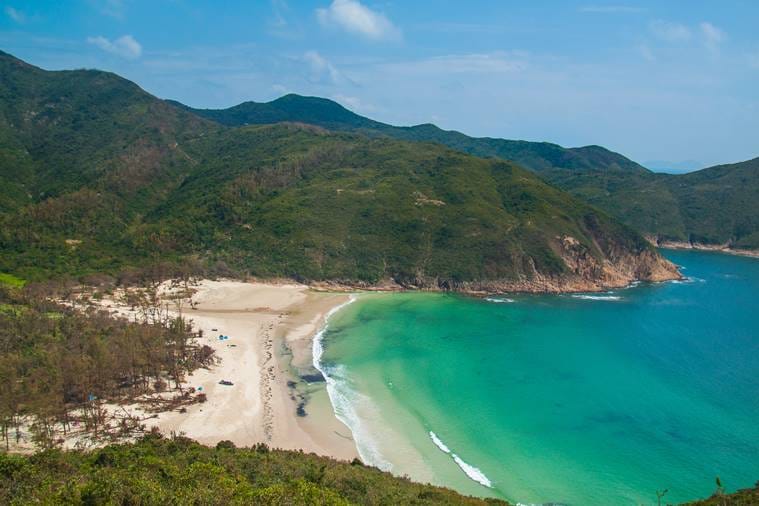
Several curved ridges of lush-green mountains extended till the horizon on my left, under the heavy veil of thick rain clouds. I was floating above an emerald swathe of forest, splintered by an occasional waterfall gushing down the cliff below me. Every few minutes, an odd hiker with a bright jacket or bag trudged past on the wooden trail up the mountain. To my right, green hills lowered down to the sea, while the brand new Hong Kong-Zhuhai-Macau Bridge disappeared into the distance. The shimmering South China Sea. Hong Kong’s bustling airport and skyline I left behind as my glass-bottomed cable car glided upwards. This is Hong Kong too, I kept telling myself, but I was certainly taken aback by the abundant greenery and the hikers on the Lantau Trail below.
I was on my way to Big Buddha and Wisdom Path on Lantau Island. The largest of all islands in Hong Kong, Lantau is primarily hilly and forested, with Lantau Peak standing tall at 934 m. Ngong Ping Plateau located on Lantau is the site of Po Lin Monastery built in 1906 and Tian Tan Buddha (popularly known as Big Buddha), a giant bronze statue built as an extension of the Po Lin Monastery. I watched in awe with my nose pressed against the glass for over the 25-minute gondola ride from Tung Chung on the northwestern coast of Lantau to the top of Ngong Ping village. Once at the village, several hiking trails and walking paths lead further on.
Following a well-laid trail through dry woodlands, I made my way towards the 38 wooden steles arranged in the shape of infinity on a mountain slope overlooking the green-carpeted Lantau peak. The calligraphy on the vertical wooden beams featured text from a scripture of Mahayana Buddhism. It was all calm and peaceful around the monument, in stark contrast to bustling Hong Kong. Ahead of me, hikers were making their way up the grassy slopes towards the peak. There are several longer trails in Lantau Island, the most popular are the trails to Lantau Peak and Sunset Peak.

Not just Lantau, the whole of Hong Kong has about 28 designated hiking trails of varying lengths and difficulty levels, spread over its many islands. Around 40 per cent of the region is earmarked for country parks and nature reserves. Once covered in tropical forests, successive waves of civilisation and modernisation decimated most of the original flora and fauna. But there has been an active effort in the past decades to reforest and bring back some of the lost glory. When I spent a few days hiking in Hong Kong, I was pleasantly surprised to find a thriving hiking culture that offered a quick escape from the space-starved, claustrophobic city. I hiked small sections of two of its 28 trails — Lantau Peak and MacLehose Trail — enveloped by green mountains, hidden white-sand beaches and blue waters.
MacLehose Trail is one of Hong Kong’s few long-distance trails stretching over 100 km across stunning coves and dense forests. When I hiked a small stretch of it to the hidden Long Ke beach, it was heartening to see entire families, grandmoms with grandkids, hiking together; men in formals hiking as an escape after work; endurance athletes running uphill. I didn’t associate a hiking culture with Hong Kong, but this helped a city-averse traveller like me find a reason to admire the city.
According to my guide, an avid hiker and Hong-Kong local Vivian Wong, the city is so compact that people like to get out of the city and be amid nature whenever they can. Some employees want to escape the incessant work calls and their bosses, perhaps, she adds with a chuckle.
On the evenings, after my day hikes, I gallivanted in double-decker trams at midnight around the empty city watching the neon lights pass by, witnessed the light and sound show, A Symphony of Lights, at from Victoria Harbour, stuffed myself with mouthwatering Cantonese cuisine and partook in delicate tea-tasting sessions. But what truly elevated my experience of exploring Hong Kong was how the buzzing city offered a peaceful haven, where I could lose myself in its unbelievable blue seas and green hills.